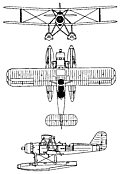 |
Kawanishi E7K Alf1933 |  |
| RECONNAISSANCE FLOAT-PLANE | Virtual Aircraft Museum / Japan / Kawanishi |
 |
In 1932 the Imperial Japanese Navy sought a replacement for the Navy Type 90-3 Reconnaissance Seaplane which had been built as the Kawanishi E5K. Th§ resulting three-seat Kawanishi E7K1 was an equal-span biplane of conventional design, powered by a 462kW HiroType91 engine. First flown on 6 February 1933, the prototype was handed over to the Japanese navy three months later for service trials, being flown in competition against the Aichi AB-6 developed to meet the same requirement. The E7K1 was ordered into production as the Navy Type 94 Reconnaissance Seaplane in May 1934, entering service in early 1935, and quickly proving popular for its ease of handling. However, its Hiro engine was unreliable, and although late production E7K1s had a more powerful version of the Hiro 91, this offered no improvement. During 1938 Kawanishi built an E7K2 prototype which, generally similar to the E7K1, replaced the Hiro engine with a Mitsubishi Zuisei 11 radial. Flown for the first time in August 1938, the E7K2 was ordered into production three months later under the designation Navy Type 94 Reconnaissance Seaplane Model 2, the original version then becoming the Navy Type 94 Reconnaissance Seaplane Model 1. Production of the E7K1 totalled 183 (57 built by Nippon), and of the E7K2 about 350 (some 60 built by Nippon). As a type the E7Ks saw extensive use from 1935 until the beginning of the Pacific war, when the E7K1s were relegated to second-line duties. The E7K2s, however, continued in first-line service until 1943, and both versions were used in kamikaze operations in the closing stages of the war. When, in the second half of 1942, Allied codenames were allocated to Japanese aircraft, the E7K2 became known as 'Alf'.

|  COMPANY PROFILE | |||||||||||||||||||||||||||||||||||||||||||||||||||||||||||||||
 |

|


20
reply